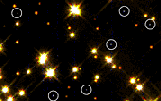

When a star with a mass similar to that of the Sun exhausts its store of nuclear energy, it can only release more energy by contracting. This will result in a star of enormous density. These objects are the extremely compact white dwarfs stars. Gradually a white dwarf cools down and after a few hundered million years it has a luminosity about 1 percent of the Sun's. |
Eventually a white dwarf will cease to shine at all and it will become a black dwarf - a cold mass of degenerate gas floating through space. We have not yet observed a black dwarf and it may be that the Galaxy is not old enough for any star to have had time to become a black dwarf. |

If a white dwarf is orbiting around another star, a novae outburst can occur if they are close enough for material to get transfered from its companion. This novae is seen as an outburst of light. A novae is only bright for a few days or weeks and then it gradually fades away. After the outburst, the white dwarf reverts to its previous state but eventually the process is repeated. |
|
Last modified 9th August 1999 Sarah Amandusson www_astro@mssl.ucl.ac.uk |